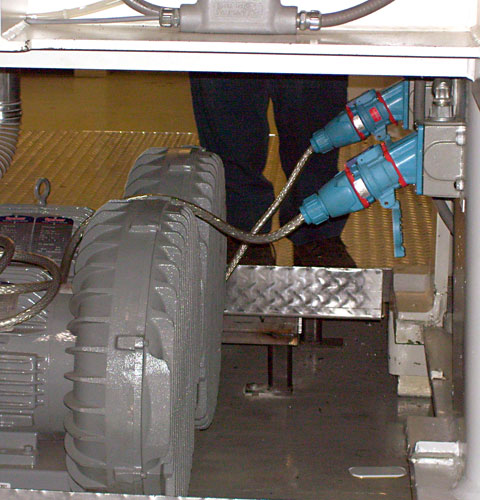Stolle Machinery Makes an Easy Connection

Power to the uncoiler in front of this Stolle Cupping System can be disconnected easily for die changing or maintenance, using the MELTRIC Switch-Rated connector visible above the die on the left side of the machine.

Blower motor for pneumatic conveying system on this Stolle End Machine can be disconnected and moved quickly with the Switch-Rated plugs and receptacles, shown at right.

An auxiliary control panel and related equipment can be safely connected and disconnected to the mating Switch-Rated receptacle on the shell press.

A load station in Stolle plant is equipped with multiple Switch-Related connectors to facilitate testing and customer runoff of new machinery.
To make the job of moving auxiliary equipment easier and safer, Stolle Machinery Company, LLC, equips the presses and other containermaking machinery it manufactures with combination plug/receptacle and disconnect switches. The MELTRIC Switch-Rated plugs and receptacles allow workers to safely make and break electrical equipment connections, even under full load. And because they are UL switch and horsepower rated they meet NEC requirements for a motor “line of sight” disconnect.
Stolle Machinery designs and builds a wide range of machinery for the production of beverage and food cans and easy-open ends, as well as inside spray systems and light testers for these containers. The company’s Container Machinery Division (Stolle CMD), based near Denver, Colorado, builds machinery for the production of two-piece beverage cans, as well as inside spray systems and light testers. Its End and Metal Forming Division (Stoll EMD) in Sydney, Ohio, builds machinery used to produce easy-open and sanitary ends, as well as cupping systems and draw-redraw systems for two-piece beverage and food cans.
Many of these units are equipped with auxiliary equipment, such as uncoilers, coil feeders, pumps, or blowers. When it is necessary to change dies or perform some types of maintenance, it may be necessary to disconnect the power lines to the auxiliary equipment so it can be moved or serviced.
Previously, the company either hard-wired auxiliary equipment or they used NEMA twist-locking connectors. Stolle sought a solution that would offer greater safety and protection from arc flash while also reducing the time needed to disconnect and reconnect the equipment. Stolle EMD Electrician Mike Harmon explains, “In the field, somebody first had to throw a disconnect switch and then open the connector or hard wiring, which makes it at least a two-step process.” Since Stolle switched to MELTRIC Switch-Rated plugs and receptacles, disconnecting power is a simple operation that is initiated by pressing a push-button offswitch on the receptacle, which breaks the circuit and ejects the plug to its rest position. Then the plug can be withdrawn from the receptacle in complete safety, since the circuit is already dead. When the plug and receptacle are separated, deenergization can be visually verified and a safety shutter prevents access to live parts, which helps simplify NFPA 70E compliance.
One Solution for Many Applications
Stolle uses the Switch-Rated devices to make electrical connections on a variety of equipment. Harmon says one typical application is on a cupping machine, which makes the bottom section that later gets formed into the body of the can. “It’s actually on a blower motor for the machine’s pneumatic conveying system,” he explains. “We also use them on blowers for our end machines and on our uncoilers.” He notes that these types of equipment are subject to being disconnected and reconnected frequently in the field when they have to be moved.
According to Harmon, workers may need to change or adjust the dies on a press such as the end machine. He says, “They can roll the uncoiler back on rails so they can open the swing-away roll feed to get into the die.” Blower motors on the pneumatic systems also may have to be removed for service. In these cases, Switch-Rated plugs and receptacles make it safer and easier to disconnect and reconnect power to the motors.
Another application is on a body maker, produced at Stolle CMD. Lead Electrical Engineer James Chapman says, “We use them to provide power to an oil filtration unit that we get from an outside vendor. This makes it easier for a Stolle customer to perform maintenance or swap it for another unit, if necessary. The units may come in different voltages, from 110 volts to 460 volts.”
Chapman says the Switch-Rated connectors also are used to connect pumps that supply varnish to Stolle’s decorators, which apply finishes to the formed cans. “They are separate pumps that sit on the floor behind the machine,” he explains. “If a pump fails, or the customer needs to pull it out for maintenance, they are now easier to disconnect and reconnect.” He adds that the receptacle is mounted on the side of the machine, but the use of a long cable allows the pump to be placed wherever it is most convenient.
Many of the machines have multiple connections. One End System press, for example, has four blowers equipped with the Switch-Rated devices. Harmon says the ability to differentiate them makes connections faster and safer. “We can rotate them to 24 different points, so we can key them to their mate, that way the operator can get the phasing right on all the plugs every time.”
For many applications, Stolle uses Switch-Rated connectors equipped with pilot contacts to monitor operation of the auxiliary equipment or integrate its operation with that of the main press. Harmon explains, “We use the extra contacts to send a signal back to the PLC that controls the machine to show that the plug is engaged and it is safe to begin operations.” Chapman adds,
“We have an interlock for the controls on the operator console, so if the operator starts the machine, it won’t allow power to turn on for that receptacle if the signal doesn’t show it is properly connected.”
Chapman says, “We went through all the NFPA 70E and other safety requirements, and the real attraction for us was the combination of safety features, which protect our personnel and our customers from arc flash and other hazards. After some of our customers have seen the Switch-Related devices on the equipment we shipped them, they began thinking about using it on other applications in their plants.” Stolle CMD has done the same and now uses MELTRIC Switch-Related connectors on load stations in the assembly area. Chapman explains, “Previously, our electricians would have to connect the power cables from the control panels to these load stations. We went with the Switch-Related devices for safety reasons, and it’s something they do on a regular basis, so it also saves a lot of time.”







